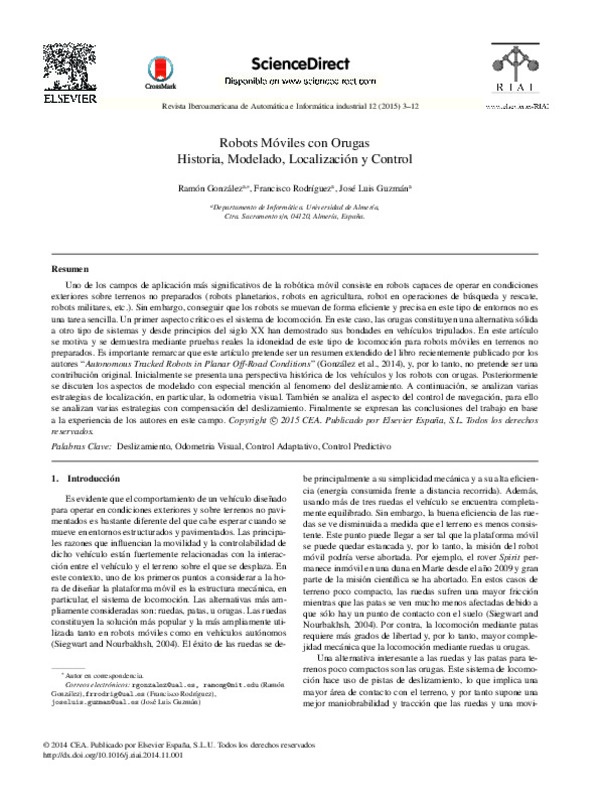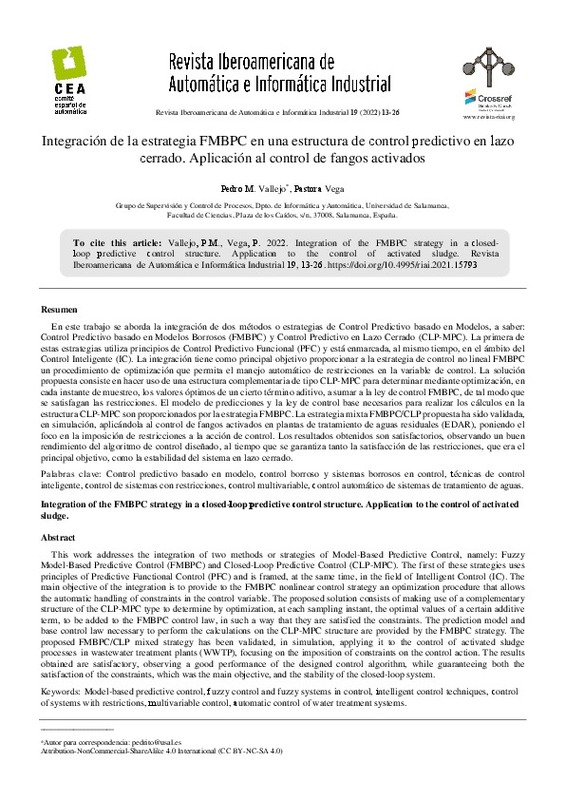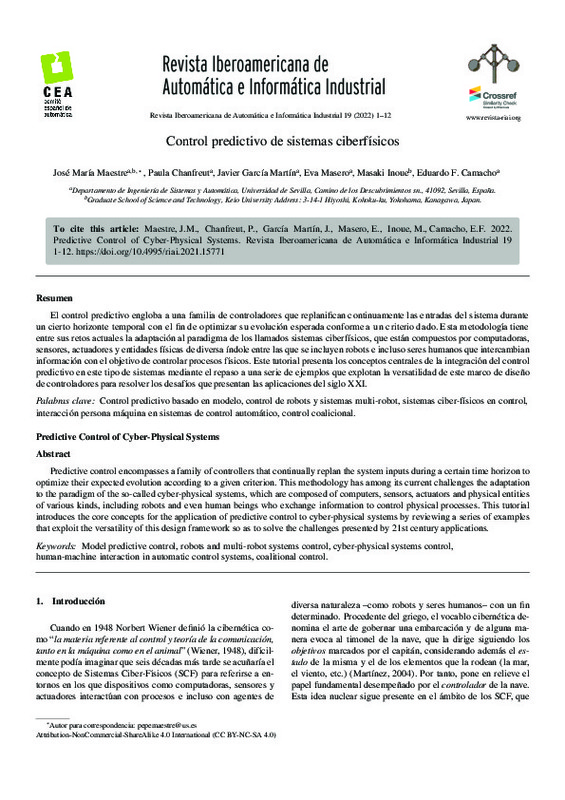JavaScript is disabled for your browser. Some features of this site may not work without it.
Buscar en RiuNet
Listar
Mi cuenta
Estadísticas
Ayuda RiuNet
Admin. UPV
Robots Móviles con Orugas Historia, Modelado, Localización y Control
Mostrar el registro sencillo del ítem
Ficheros en el ítem
| dc.contributor.author | González, Ramón
|
es_ES |
| dc.contributor.author | Rodríguez, Francisco
|
es_ES |
| dc.contributor.author | Guzmán, José Luis
|
es_ES |
| dc.date.accessioned | 2020-05-20T09:21:39Z | |
| dc.date.available | 2020-05-20T09:21:39Z | |
| dc.date.issued | 2015-01-11 | |
| dc.identifier.issn | 1697-7912 | |
| dc.identifier.uri | http://hdl.handle.net/10251/143838 | |
| dc.description.abstract | [ES] Uno de los campos de aplicación más significativos de la robótica móvil consiste en robots capaces de operar en condiciones exteriores sobre terrenos no preparados (robots planetarios, robots en agricultura, robot en operaciones de búsqueda y rescate, robots militares, etc.). Sin embargo, conseguir que los robots se muevan de forma eficiente y precisa en este tipo de entornos no es una tarea sencilla. Un primer aspecto crítico es el sistema de locomoción. En este caso, las orugas constituyen una alternativa sólida a otro tipo de sistemas y desde principios del siglo XX han demostrado sus bondades en vehículos tripulados. En este artículo se motiva y se demuestra mediante pruebas reales la idoneidad de este tipo de locomoción para robots móviles en terrenos no preparados. Es importante remarcar que este artículo pretende ser un resumen extendido del libro recientemente publicado por los autores “Autonomous Tracked Robots in Planar Off-Road Conditions” (González et al., 2014), y, por lo tanto, no pretende ser una contribución original. Inicialmente se presenta una perspectiva histórica de los vehículos y los robots con orugas. Posteriormente se discuten los aspectos de modelado con especial mención al fenomeno del deslizamiento. A continuación, se analizan varias estrategias de localización, en particular, la odometria visual. También se analiza el aspecto del control de navegación, para ello se analizan varias estrategias con compensación del deslizamiento. Finalmente se expresan las conclusiones del trabajo en base a la experiencia de los autores en este campo. | es_ES |
| dc.description.abstract | [EN] One of the most significant research field in mobile robotics deals with robots operating in off-road conditions (planetary rovers, agriculture robots, search and rescue operations, military robots, etc.). However, obtaining a successful result is not an easy task. One primary point is the locomotion system. In this case, tracks constitute a well-known approach and since the beginning of the 20th century this locomotion system has demonstrated remarkable results in manned vehicles. This article motivates and shows through physical experiments the goodness of tracked mobile robots in off-road conditions. Firstly, a historical perspective of tracked vehicles and tracked robots is addressed. Then, the main modelling aspects are introduced, in particular, the slip phenomenon. After that, several localization techniques are discussed with especial mention to visual odometry. The motion control aspect is also of primal importance. In this regard, several slip-compensation control strategies are analysed. Finally, the authors background obtained in this field is expounded. | es_ES |
| dc.description.sponsorship | Este trabajo ha sido realizado en el marco del proyecto Controlcrop PIO-TEP-6174, financiado por la Consejería de Economía, Innovación y Ciencia de la Junta de Andalucía (España). | es_ES |
| dc.language | Español | es_ES |
| dc.publisher | Universitat Politècnica de València | es_ES |
| dc.relation.ispartof | Revista Iberoamericana de Automática e Informática industrial | es_ES |
| dc.rights | Reconocimiento - No comercial - Sin obra derivada (by-nc-nd) | es_ES |
| dc.subject | Slip | es_ES |
| dc.subject | Visual Odometry | es_ES |
| dc.subject | Adaptive Control | es_ES |
| dc.subject | Predictive Control | es_ES |
| dc.subject | Deslizamiento | es_ES |
| dc.subject | Odometria Visual | es_ES |
| dc.subject | Control Adaptativo | es_ES |
| dc.subject | Control Predictivo | es_ES |
| dc.title | Robots Móviles con Orugas Historia, Modelado, Localización y Control | es_ES |
| dc.title.alternative | Autonomous Tracked Robots. History, Modelling, Localization, and Motion Control | es_ES |
| dc.type | Artículo | es_ES |
| dc.identifier.doi | 10.1016/j.riai.2014.11.001 | |
| dc.relation.projectID | info:eu-repo/grantAgreement/Junta de Andalucía//PIO-TEP-6174/ | es_ES |
| dc.rights.accessRights | Abierto | es_ES |
| dc.description.bibliographicCitation | González, R.; Rodríguez, F.; Guzmán, JL. (2015). Robots Móviles con Orugas Historia, Modelado, Localización y Control. Revista Iberoamericana de Automática e Informática industrial. 12(1):3-12. https://doi.org/10.1016/j.riai.2014.11.001 | es_ES |
| dc.description.accrualMethod | OJS | es_ES |
| dc.relation.publisherversion | https://doi.org/10.1016/j.riai.2014.11.001 | es_ES |
| dc.description.upvformatpinicio | 3 | es_ES |
| dc.description.upvformatpfin | 12 | es_ES |
| dc.type.version | info:eu-repo/semantics/publishedVersion | es_ES |
| dc.description.volume | 12 | es_ES |
| dc.description.issue | 1 | es_ES |
| dc.identifier.eissn | 1697-7920 | |
| dc.relation.pasarela | OJS\9404 | es_ES |
| dc.contributor.funder | Junta de Andalucía | es_ES |
| dc.description.references | Angelova, A., Matthies, L., Helmick, D., & Perona, P. (2007). Learning and prediction of slip from visual information. Journal of Field Robotics, 24(3), 205-231. doi:10.1002/rob.20179 | es_ES |
| dc.description.references | Benoit, O., Gotteland, P., & Quibel, A. (2003). Prediction of trafficability for tracked vehicle on broken soil: real size tests. Journal of Terramechanics, 40(2), 135-160. doi:10.1016/j.jterra.2003.10.003 | es_ES |
| dc.description.references | Borenstein, J., May 1994. The CLAPPER: A Dual–drive Mobile Robot with Internal Correction of Dead–reckoning Errors. IEEE Conference on Robotics and Automation, IEEE, pp. 3085-3090, San Diego, USA. | es_ES |
| dc.description.references | Cariou, C., Lenain, R., Thuilot, B., & Berducat, M. (2009). Automatic guidance of a four-wheel-steering mobile robot for accurate field operations. Journal of Field Robotics, 26(6-7), 504-518. doi:10.1002/rob.20282 | es_ES |
| dc.description.references | Crolla, D. A., & Schwanghart, H. (1992). Vehicle dynamics—Steering I. Journal of Terramechanics, 29(1), 7-17. doi:10.1016/0022-4898(92)90011-8 | es_ES |
| dc.description.references | Endo, D., Okada, Y., Nagatani, K., Yoshida, K., October 2007. Path Following Control for Tracked Vehicles Based on Slip–Compensating Odometry. IEEE International Conference on Intelligent Robots and Systems, IEEE, pp. 2871-2876, san Diego, USA. | es_ES |
| dc.description.references | Gonzalez, R., Fiacchini, M., Alamo, T., Guzman, J. L., & Rodriguez, F. (2010). Adaptive Control for a Mobile Robot Under Slip Conditions Using an LMI-Based Approach. European Journal of Control, 16(2), 144-155. doi:10.3166/ejc.16.144-155 | es_ES |
| dc.description.references | González, R., Rodríguez, F., Guzmán, J.L., 2014. Autonomous Tracked Robots in Planar Off-Road Conditions. Modelling, Localization and Motion Control. Series: Studies in Systems, Decision and Control. Springer, Germany. | es_ES |
| dc.description.references | Gonzalez, R., Rodriguez, F., Guzman, J. L., Pradalier, C., & Siegwart, R. (2011). Combined visual odometry and visual compass for off-road mobile robots localization. Robotica, 30(6), 865-878. doi:10.1017/s026357471100110x | es_ES |
| dc.description.references | Gracia, L., & Tornero, J. (2007). Kinematic modeling of wheeled mobile robots with slip. Advanced Robotics, 21(11), 1253-1279. doi:10.1163/156855307781503763 | es_ES |
| dc.description.references | Helmick, D., Angelova, A., & Matthies, L. (2009). Terrain Adaptive Navigation for planetary rovers. Journal of Field Robotics, 26(4), 391-410. doi:10.1002/rob.20292 | es_ES |
| dc.description.references | Helmick, D. M., Roumeliotis, S. I., Cheng, Y., Clouse, D. S., Bajracharya, M., & Matthies, L. H. (2006). Slip-compensated path following for planetary exploration rovers. Advanced Robotics, 20(11), 1257-1280. doi:10.1163/156855306778792470 | es_ES |
| dc.description.references | Hohl, G. H. (2007). Military terrain vehicles. Journal of Terramechanics, 44(1), 23-34. doi:10.1016/j.jterra.2006.01.003 | es_ES |
| dc.description.references | Iagnemma, K., Dubowsky, S., September 2000. Mobile Robot Rough–Terrain Control (RTC) for Planetary Exploration. ASME Biennial Mechanisms and Robotics Conference, ASME, pp. 10-13, Baltimore, USA. | es_ES |
| dc.description.references | Iagnemma, K., Dubowsky, S., 2004. Mobile Robots in Rough Terrain. Estimation, Motion Planning, and Control with Application to Planetary Rovers. Springer Tracts in Advanced Robotics. Springer, Germany. | es_ES |
| dc.description.references | Iagnemma, K., Kang, S., Shibly, H., & Dubowsky, S. (2004). Online Terrain Parameter Estimation for Wheeled Mobile Robots With Application to Planetary Rovers. IEEE Transactions on Robotics, 20(5), 921-927. doi:10.1109/tro.2004.829462 | es_ES |
| dc.description.references | Iagnemma, K., & Ward, C. C. (2008). Classification-based wheel slip detection and detector fusion for mobile robots on outdoor terrain. Autonomous Robots, 26(1), 33-46. doi:10.1007/s10514-008-9105-8 | es_ES |
| dc.description.references | Ishigami, G., Nagatani, K., & Yoshida, K. (2009). Slope traversal controls for planetary exploration rover on sandy terrain. Journal of Field Robotics, 26(3), 264-286. doi:10.1002/rob.20277 | es_ES |
| dc.description.references | Johnson, A.E., Goldberg, S.B., Yang, C., Matthies, L.H., May 2008. Robust and Efficient Stereo Feature Tracking for Visual Odometry. In: IEEE International Conference on Robotics and Automation. IEEE, pp. 39-46, Pasadena, USA. | es_ES |
| dc.description.references | Kanayama, Y., Kimura, Y., Miyazaki, F., Noguchi, T., 1990. A Stable Tracking Control Method for an Autonomous Mobile Robots. IEEE International Conference on Robotics and Automation, IEEE, pp. 384-389, Cincinnati, USA. | es_ES |
| dc.description.references | Korlath, G. (2007). Mobility analysis of off-road vehicles: Benefits for development, procurement and operation. Journal of Terramechanics, 44(5), 383-393. doi:10.1016/j.jterra.2007.10.007 | es_ES |
| dc.description.references | Krebs, A., Thueer, T., Carrasco, E., Siegwart, R., February 2008. Towards Torque Control of the CRAB Rover. International Symposium on Artificial Intelligence, Robotics and Automation in Space, Los Angeles, USA. | es_ES |
| dc.description.references | Labrosse, F. (2006). The visual compass: Performance and limitations of an appearance-based method. Journal of Field Robotics, 23(10), 913-941. doi:10.1002/rob.20159 | es_ES |
| dc.description.references | Le, A., 1999. Modelling and Control of Tracked Vehicles. PhD Thesis, University of Sydney, Sydney, Australia in press. | es_ES |
| dc.description.references | Lenain, R., Thuilot, B., Cariou, C., & Martinet, P. (2007). Adaptive and Predictive Path Tracking Control for Off-road Mobile Robots. European Journal of Control, 13(4), 419-439. doi:10.3166/ejc.13.419-439 | es_ES |
| dc.description.references | Leung, T., & Malik, J. (2001). International Journal of Computer Vision, 43(1), 29-44. doi:10.1023/a:1011126920638 | es_ES |
| dc.description.references | Liu, Y., Liu, G., 2009. Mobile Manipulation using Tracks of a Tracked Mobile Robot. In: IEEE Int. Conf. on Intelligent Robots and Systems (IROS). IEEE, pp. 948-953. | es_ES |
| dc.description.references | Chang Boon Low, & Danwei Wang. (2008). GPS-Based Path Following Control for a Car-Like Wheeled Mobile Robot With Skidding and Slipping. IEEE Transactions on Control Systems Technology, 16(2), 340-347. doi:10.1109/tcst.2007.903100 | es_ES |
| dc.description.references | Martínez, J. L., Mandow, A., Morales, J., Pedraza, S., & García-Cerezo, A. (2005). Approximating Kinematics for Tracked Mobile Robots. The International Journal of Robotics Research, 24(10), 867-878. doi:10.1177/0278364905058239 | es_ES |
| dc.description.references | Matthies, L., Maimone, M., Johnson, A., Cheng, Y., Willson, R., Villalpando, C., … Angelova, A. (2007). Computer Vision on Mars. International Journal of Computer Vision, 75(1), 67-92. doi:10.1007/s11263-007-0046-z | es_ES |
| dc.description.references | Mayne, D. Q., Rawlings, J. B., Rao, C. V., & Scokaert, P. O. M. (2000). Constrained model predictive control: Stability and optimality. Automatica, 36(6), 789-814. doi:10.1016/s0005-1098(99)00214-9 | es_ES |
| dc.description.references | McNae, A., 2000. A History of Komatsu: Construction and Mining Equipment. Beenleigh, Qld. | es_ES |
| dc.description.references | Montiel, J., Davison, A., May 2006. A Visual Compass based on SLAM. IEEE International Conference on Robotics and Automation, IEEE, pp. 1917-1922, Orlando, USA. | es_ES |
| dc.description.references | Morales, J., Martinez, J. L., Mandow, A., Garcia-Cerezo, A. J., & Pedraza, S. (2009). Power Consumption Modeling of Skid-Steer Tracked Mobile Robots on Rigid Terrain. IEEE Transactions on Robotics, 25(5), 1098-1108. doi:10.1109/tro.2009.2026499 | es_ES |
| dc.description.references | Mourikis, A. I., Trawny, N., Roumeliotis, S. I., Helmick, D. M., & Matthies, L. (2007). Autonomous Stair Climbing for Tracked Vehicles. The International Journal of Robotics Research, 26(7), 737-758. doi:10.1177/0278364907080423 | es_ES |
| dc.description.references | Nourani-Vatani, N., Roberts, J., Srinivasan, M., May 2009. Practical Visual Odometry for Car–like Vehicles. IEEE International Conference on Robotics and Automation, IEEE, pp. 3551-3557, Kobe, Japan. | es_ES |
| dc.description.references | Oriolo, G., De Luca, A., & Vendittelli, M. (2002). WMR control via dynamic feedback linearization: design, implementation, and experimental validation. IEEE Transactions on Control Systems Technology, 10(6), 835-852. doi:10.1109/tcst.2002.804116 | es_ES |
| dc.description.references | Ray, L. E. (2009). Estimation of Terrain Forces and Parameters for Rigid-Wheeled Vehicles. IEEE Transactions on Robotics, 25(3), 717-726. doi:10.1109/tro.2009.2018971 | es_ES |
| dc.description.references | Rubinstein, D., & Coppock, J. L. (2007). A detailed single-link track model for multi-body dynamic simulation of crawlers. Journal of Terramechanics, 44(5), 355-364. doi:10.1016/j.jterra.2007.10.004 | es_ES |
| dc.description.references | Sánchez-Hermosilla, J., Rodríguez, F., González, R., Guzmán, J., Berenguel, M., 2010. A Mechatronic Description of an Autonomous Mobile Robot for Agricultural Tasks in Greenhouses. In: Barrera, A. (Ed.), Mobile Robots Navigation. InTech, pp. 583-608. | es_ES |
| dc.description.references | Shoval, S., 2004. Stability of a Multi Tracked Robot Traveling over Steep Slopes. In: IEEE Int. Conf. on Robotics and Automation (ICRA). Vol. 5. IEEE, pp. 4701-4706. | es_ES |
| dc.description.references | Siegwart, R., Nourbakhsh, I., 2004. Introduction to Autonomous Mobile Robots, First Edition. A Bradford book. The MIT Press, USA. | es_ES |
| dc.description.references | Wan, J., Vehi, J., & Luo, N. (2008). A numerical approach to design control invariant sets for constrained nonlinear discrete-time systems with guaranteed optimality. Journal of Global Optimization, 44(3), 395-407. doi:10.1007/s10898-008-9334-6 | es_ES |
| dc.description.references | Danwei Wang, & Chang Boon Low. (2008). Modeling and Analysis of Skidding and Slipping in Wheeled Mobile Robots: Control Design Perspective. IEEE Transactions on Robotics, 24(3), 676-687. doi:10.1109/tro.2008.921563 | es_ES |
| dc.description.references | Wong, J. Y. (1984). An introduction to terramechanics. Journal of Terramechanics, 21(1), 5-17. doi:10.1016/0022-4898(84)90004-1 | es_ES |
| dc.description.references | Wong, J. Y., & Huang, W. (2006). «Wheels vs. tracks» – A fundamental evaluation from the traction perspective. Journal of Terramechanics, 43(1), 27-42. doi:10.1016/j.jterra.2004.08.003 | es_ES |
| dc.description.references | Yi, J., Song, D., Zhang, J., Goodwin, Z., April 2007. Adaptive Trajectory Tracking Control of Skid–Steered Mobile Robots. International Conference on Robotics and Automation, IEEE, pp. 2605-2610, Rome, Italy. | es_ES |
| dc.description.references | Jingang Yi, Hongpeng Wang, Junjie Zhang, Dezhen Song, Jayasuriya, S., & Jingtai Liu. (2009). Kinematic Modeling and Analysis of Skid-Steered Mobile Robots With Applications to Low-Cost Inertial-Measurement-Unit-Based Motion Estimation. IEEE Transactions on Robotics, 25(5), 1087-1097. doi:10.1109/tro.2009.2026506 | es_ES |
| dc.description.references | Luo, Z., Shang, J., & Zhang, Z. (2013). A reconfigurable tracked mobile robot based on four-linkage mechanism. Journal of Central South University, 20(1), 62-70. doi:10.1007/s11771-013-1460-8 | es_ES |











